Are you familiar with the key differences between a Tune-O-Matic vs wrap-around bridge and why they’re important? In this article, I’ll reveal the pros and cons of each bridge type and how they affect the guitar as a whole.
Keep reading to learn everything you need to choose the guitar bridge that’s right for you!
You can use the table of contents below to take you to the area that interests you. Click on the little box to open it, and then click on the section of the article you want to read, or you can read from start to finish if you want the full guitar bridge experience!
The Short Answer
A Tune-O-Matic design uses a stop-tail piece and an adjustable bridge, while a wrap-around bridge contains both in a single unit. They are usually found on Gibson and PRS guitars. Each bridge type has its own tone, sustain, and playability characteristics. Choosing the bridge type that best fits your playing style is essential.
Keep On Reading (Below) To Learn More
Guitar Bridge Comparison

Here’s a table that compares the most important characteristics of each bridge type.
To get more in-depth info, click on the Tune-O-Matic and Wrap-Around Bridge headings in the table below.
| Comparison | Tune-O-Matic-Bridge | Wrap-Around Bridge |
|---|---|---|
| Used | Commonly on Gibson & SG guitars | On some Gibson & PRS guitars |
| Construction | Two-piece bridge | One-piece bridge |
| Tuning Stability | Good | Good to excellent |
| Intonation | Moveable Saddles | Compensated bridge & Allen screws |
| Re-stringing | Can be challenging | Easier |
| Palm Muting | Less comfortable | More comfortable |
| Tone | Warmer | Brighter |
| Sustain | Good | Better |
| Tremolo Arm | Can be added | Cannot be added without significant modification |
Keep On Reading (Below) To Learn More About Each Topic
Which Guitars Have These Bridge Types?
Tune O Matic Bridge
Ted McCarty invented the Tune-O-Matic bridge as Gibson’s first fully-adjustable bridge. It was first used in 1954 on Gibson’s Les Paul Custom guitar.
It is commonly found on Gibson guitars like the Les Paul, SG, ES-335, Explorer, Flying V, and Firebird guitars. These days, there are many third-party choices available, like the Tonepros Tune O Matic bridge.

Wrap-Around Bridge
Wrap-around bridges are found on some Gibson Custom Shop and Les Paul Junior guitars. They are also used on Epiphone and PRS hardtail (non-tremolo) guitars.
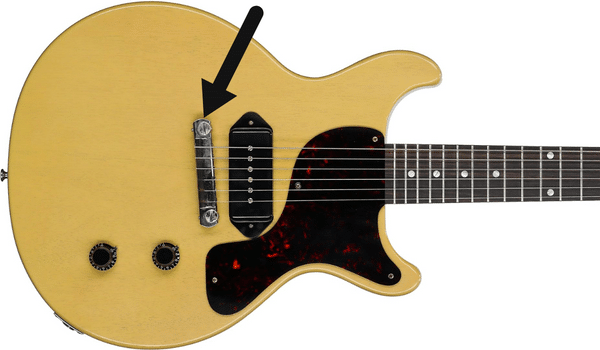
Wrap-Around Bridge
What About Fender Guitars?
The classic Tune-o-Matic and wrap-around bridges are not found on Fender guitars, except on one-off custom shop models.
The Fender Jaguar and Jazz master guitars have their proprietary version of a tremolo stop-piece with a Tune-O-Matic bridge.

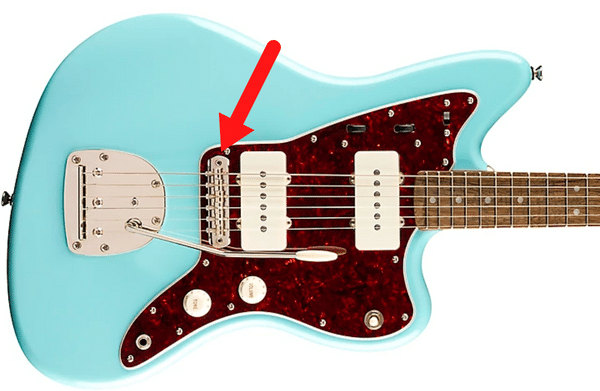
(See, Is A Jazzmaster Good For Beginners? – What You Need To Know! for more info.)
Kurt Cobain had Tune-O-Matic bridges installed on his Fender Jaguar guitars, giving rise to Fender’s version of the “Jag-Stang,” which has a one-piece “tremolo/Tune-O-Matic” tailpiece.
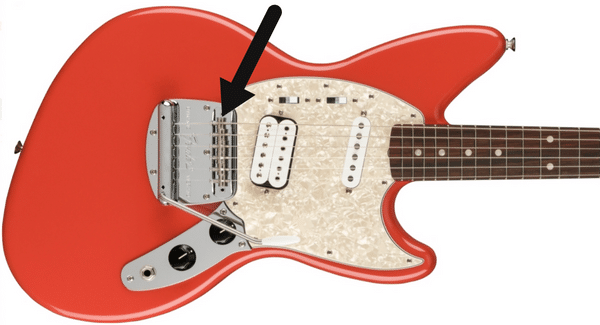
Anatomy Of A Tune-O-Matic Bridge
Here are the various parts of a Tune-O-Matic-bridge.
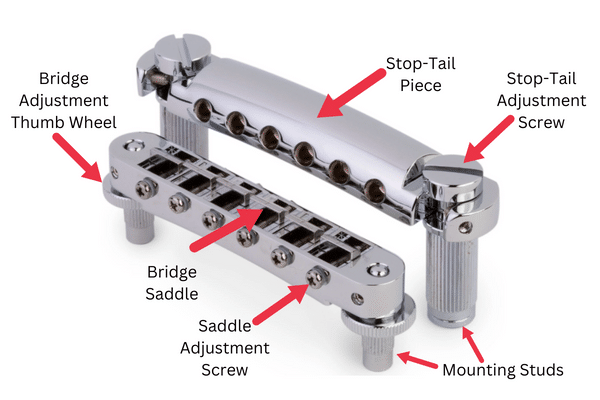
Tune-O-Matic Bridge Characteristics
Construction
The classic Tune-O-Matic bridge consists of two pieces. It has a stop-tail piece and an adjustable bridge, as in the photo above.
The stop-tail piece anchors the guitar string ends and adjusts the string angle at the back of the adjustable bridge.
The adjustable bridge has individual saddles to adjust intonation and thumbwheels that move it up and down to set the string height (action).
Tuning Stability
The tuning stability of the adjustable bridge is generally good.
Intonation
The individually adjustable saddles on the adjustable bridge make it easy to achieve excellent intonation.
Re-Stringing
I find that re-stringing a guitar with a Tune-O-Matic bridge can be challenging if you want to remove all the strings at once to clean the instrument. In this case, it’s easy to accidentally turn the thumbwheels without the downward string pressure. This will require you to readjust the guitar’s action (string height).
Palm Muting
Some players feel that resting their hand on the adjustable bridge saddles for an extended time can become uncomfortable. I have never found this to be a problem.
Tone
The combination of the stop-tail and adjustable pieces gives it a fairly warm-sounding tone compared to the wrap-around bridge, all other things being equal.
Sustain
This bridge configuration gives good but not ideal sustain because the string vibration going into the guitar’s body is divided into two distinct areas.
Tremolo Arm
A Tune-O-Matic bridge configuration can accommodate a tremolo arm (whammy bar). Some Gibson SG guitars have the Maestro “Vibrola” tremolo arm in place of the stop-tail piece.
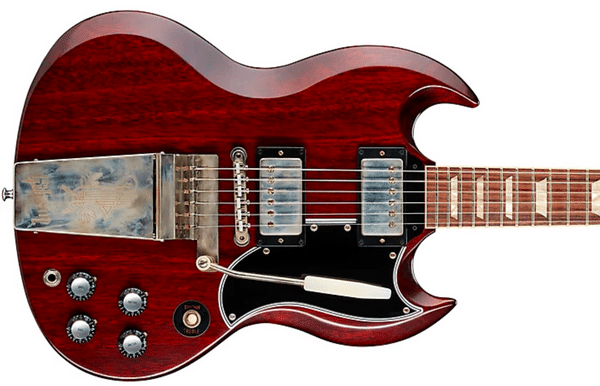
It is possible to convert a guitar with a Tune-O-Matic bridge to a tremolo arm configuration. You should not attempt this modification without the proper tools and training, or you could permanently damage your guitar. Bring it to a certified guitar tech or luthier.
“Top Wrapping” A Tune-O-Matic Bridge
Some players prefer to “top wrap” the strings over the stop-tail piece instead of through it. This type of string placement gives you a “tighter” sound and more sustain because it increases the string length in contact with the stop-tail piece, raises the string angle on the back of the adjustable bridge, and decreases the string tension.
Top wrapping can give you a sound that’s closer to a wrap-around bridge but with warmer overtones.

Here is a photo of a Tune-O-Matic bridge setup in which the strings are inserted through the back of the stop-tail piece without being wrapped around the top.
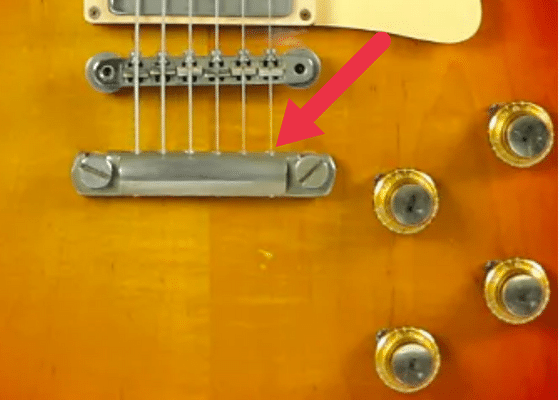
Wrap-Around Bridge Types
Here are the various types of wrap-around bridges. Note that each design has an Allen set screw on both ends that can move the bridge toward or away from the guitar nut.
Classic (Intonated) Wrap-Around Bridge
This is the original wrap-around bridge design used on the first Gibson electric guitars and continues to be used today. The top of the bridge is shaped to help intonate the various strings.
Although this bridge design is the most primitive, it gives the “Classic” wrap-around sound.
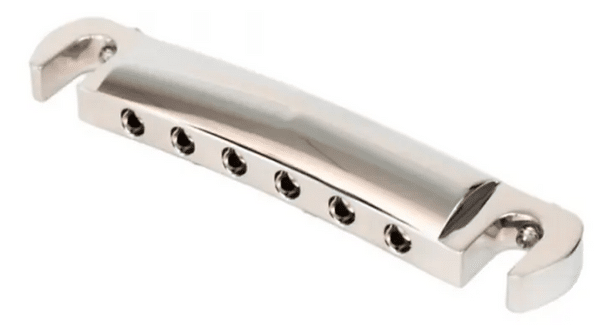
Compensated Wrap-Around Bridge
Some bridges have specific ” compensated ” areas to make intonation more accurate. They are generally easier to intonate than the classic wrap-around design but sound different.
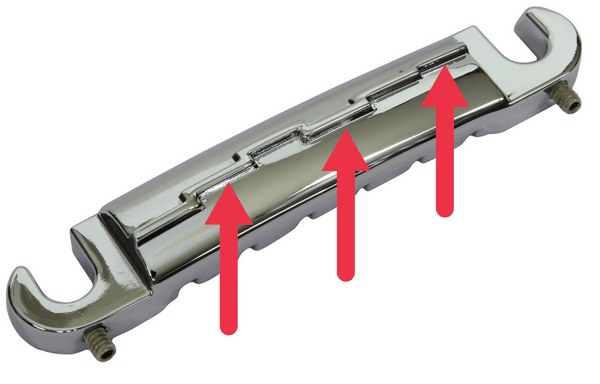
Wrap-Around Bridge With Adjustable Saddles
This design has individually adjustable saddles for each string. It is the easiest to intonate accurately, but some players think the sound of this bridge type is “thin” sounding, especially on thinner-body guitars like a Gibson SG.

Wrap-Around Bridge Characteristics
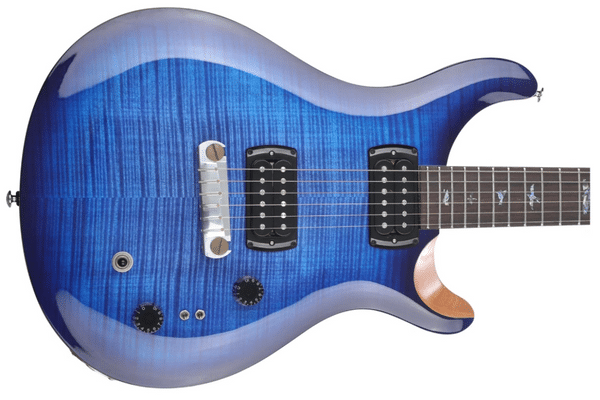
Construction
The wrap-around configuration uses a one-piece bridge, which makes it a simpler and more compact design than the classic Tune-O-Matic bridge.
Tuning Stability
This bridge can give excellent tuning stability because the strings go directly from it to the guitar nut.
Intonation
Intonation has the potential to be problematic, depending on the actual design (see bridge types above). Bridges with adjustable saddles and a compensated design tend to have better intonation than the classic wrap-around bridge.
Each side of a wrap-around bridge has an Allen set screw that can move that side closer or farther from the nut, which is helpful for proper intonation.
Re-Stringing
Compared to the classic Tune-O-Matic design, the single-piece wrap-around bridge makes it easier to re-string the guitar, especially when removing all the strings at once.
Palm Muting
Palm muting can feel more comfortable on wrap-around bridge designs without individually adjustable saddles since the top is smoother than the Tune-O-Matic bridge. This could be a factor for players that do a lot of palm muting.
Tone
The tone of wrap-around bridges is typically brighter with more attack than the Tune-O-Matic type.
If you want to balance out the warmth of a guitar’s humbucker pickups, a wrap-around bridge might be the way to go.
Sustain
The wrap-around bridge generally has more sustain than a Tune-O-Matic bridge, even if it is top-wrapped. This is primarily because all the string vibration is transferred into the guitar body’s wood from a single bridge piece.
Tremolo Arm
The wrap-around bridge does not easily accommodate a modification for a tremolo arm. Removing the bridge and installing a tremolo system is a significant undertaking, which may be too costly to justify.
Which Bridge Is Better?

No one bridge type is the best choice for any guitar or playing style. A guitar’s bridge is only one component that determines its overall tone and sustain. The guitar’s body and neck tonewood, thickness, pickups, electronics, nuts, and tuning machines can all change the sound of a guitar.
The best approach is to play several makes and models of guitars and select the one that sounds best, regardless of its bridge type.
Are You Qualified To Make Guitar Adjustments Or Modifications?
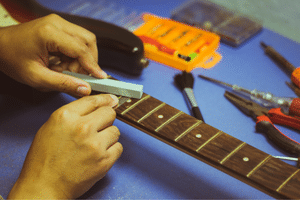
It’s great to work on your guitars, especially if you have a lot of them, but you should always be aware of your limitations.
Adjusting things like an electric guitar’s string height (action) or pickup height can be straightforward. Still, some adjustments require the proper training and experience, like adjusting a guitar’s truss rod.
Replacing the bridge on a guitar can require quite a bit of expertise to get everything right, especially the intonation.
When you doubt your ability to adjust, repair, or modify your guitar, it’s always best to bring it to a competent guitar technician or luthier (guitar designer & builder). You can permanently damage your guitar, and it might never play and sound right again!
Making modifications to your guitar can void its manufacturer’s warranty and cause permanent damage to the instrument. Certain modifications are irreversible, so you may be stuck with them, even if you desperately want to restore the guitar to its original condition!
I learned that the hard way over the years until I did a three-year apprenticeship in a guitar repair shop. Now I have my own home workshop with the proper training and equipment to safely maintain and repair all my instruments.
Remember: “When In Doubt, Send It Out!”
Frequently Asked Questions

Here are some of the questions I get asked about guitar bridges.
If your question does not appear here, please put it in the comments, and I will get right back to you with an answer.
What Is The Purpose Of A Guitar Bridge?
A guitar bridge is a device that secures the strings at the far end of the instrument and transfers the vibrations into the wood. It also sets the proper intonation at the neck and the action (string height).
Can You Play A Guitar Without A bridge?
No, all electric and acoustic guitars need some type of bridge. A proper bridge is a critical component of an acoustic guitar since it vibrates the top to produce sound.
Are All Guitar Bridges The Same Size?
No, guitar bridges come in a variety of sizes and shapes. It’s essential to put the correct bridge on each guitar.
Should You Rest Your Hand On The Guitar Bridge?
Resting your hand lightly on the guitar bridge to position it properly and allow small wrist movements is ok. Some players find this position more comfortable and easier to pick notes quickly. You can press the palm of your hand down on the bridge to create muted notes.
How Do I Stop My Bridge From Breaking Strings?
If you are breaking strings at the bridge, chances are that you have a bridge saddle(s) with a sharp edge or burr. If you have a tremolo bridge and are breaking strings when raising the pitch with the whammy bar, you may need to use a thicker string set.
Where Should A Guitar Bridge Be Placed?
It is essential to place the bridge in the position so that the distance from where the strings contact the saddles to the nut equals the guitar’s scale length. A guitar’s scale length is twice the distance from the nut to the 12th fret.
Final Thoughts

I hope you found this article on Tune-O-Matic Vs Wrap-Around Bridge helpful. Tune-O-Matic bridges are more commonly found on Gibson guitars than the wrap-around design. Wrap-around bridges are used on some Gibson and PRS (Paul Reed Smith) guitars.
A Tune-O-Matic design uses a stop-tail piece and an adjustable bridge, while a wrap-around bridge contains both in a single unit. Each bridge type has its own tone, sustain, and playability characteristics.
A Tune-O-Matic bridge typically provides a warmer tone and better intonation. However, a wrap-around bridge has more attack with a brighter sound and better sustain. Both bridges offer good tuning stability.
A Tune-O-Matic bridge can be “Top Wrapped” to give it a “tighter” sound and improved sustain.
Fender uses a variation of the classical Tune-O-Matic bridge on its Jaguar, Jazzmaster, and Jag-Stang guitars.
It’s important to choose the bridge type that best fits your playing style.

Here’s a video from String Tech Workstations that shows you when you might want to top-wrap a guitar with a Tune-O-Matic bridge. Check it out!
Tell Me What You Think

Please leave a comment below if you enjoyed this article, have any questions about these guitar bridges, or want to give your point of view. I will be happy to help you.
- Have you played guitars with both bridge types? Which do you prefer and why?
- Do you top-wrap your Tune-O-Matic bridge? Why?
- After reading this article, are you thinking of changing bridge types? Why?
- What else is on your mind?

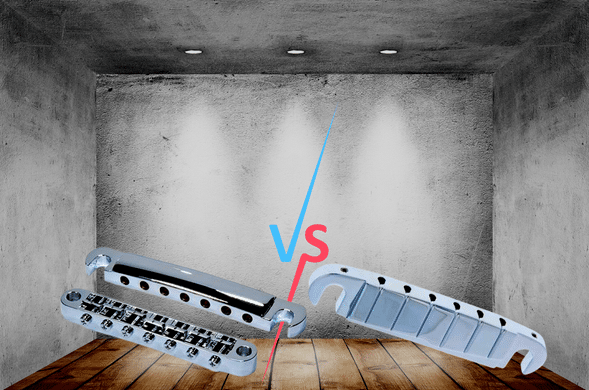

I love your website and how easy it was to navigate through. It really shows me how passionate you are about your music and your guitars. I have no doubt this is one of the best websites out there that is not only an enjoyable read but also full of knowledgeable talent! Keep up the good work and the professionalism that definitely stuck out to me in this website you clearly are so invested in. I appreciate the opportunity to leave a comment and hope to see more in the future.
Kevin and Son
Hi, Kevin
I really appreciate your comments!
Frank 🎸
First of all, I want to say I am jealous of anyone who can play the guitar. I tried to learn a few years ago but due to 2 shoulder injuries I could not get comfy with it.
Your article is very well written so that a newbie or more experienced player would get benefit from it. I really had no idea there was so much involved in the bridge of a guitar. Yes, I knew it was important but not the extent of the importance. I love listening to good guitar players. I think your article will help so many players decide on whether to change or adjust bridges.
Keep up the good writing and happy playing.
Hi, Kevin
Thank You for your comments!
Sorry to hear about your shoulders.
Maybe, at some point, you will be able to give the guitar another try.
Frank 🎸